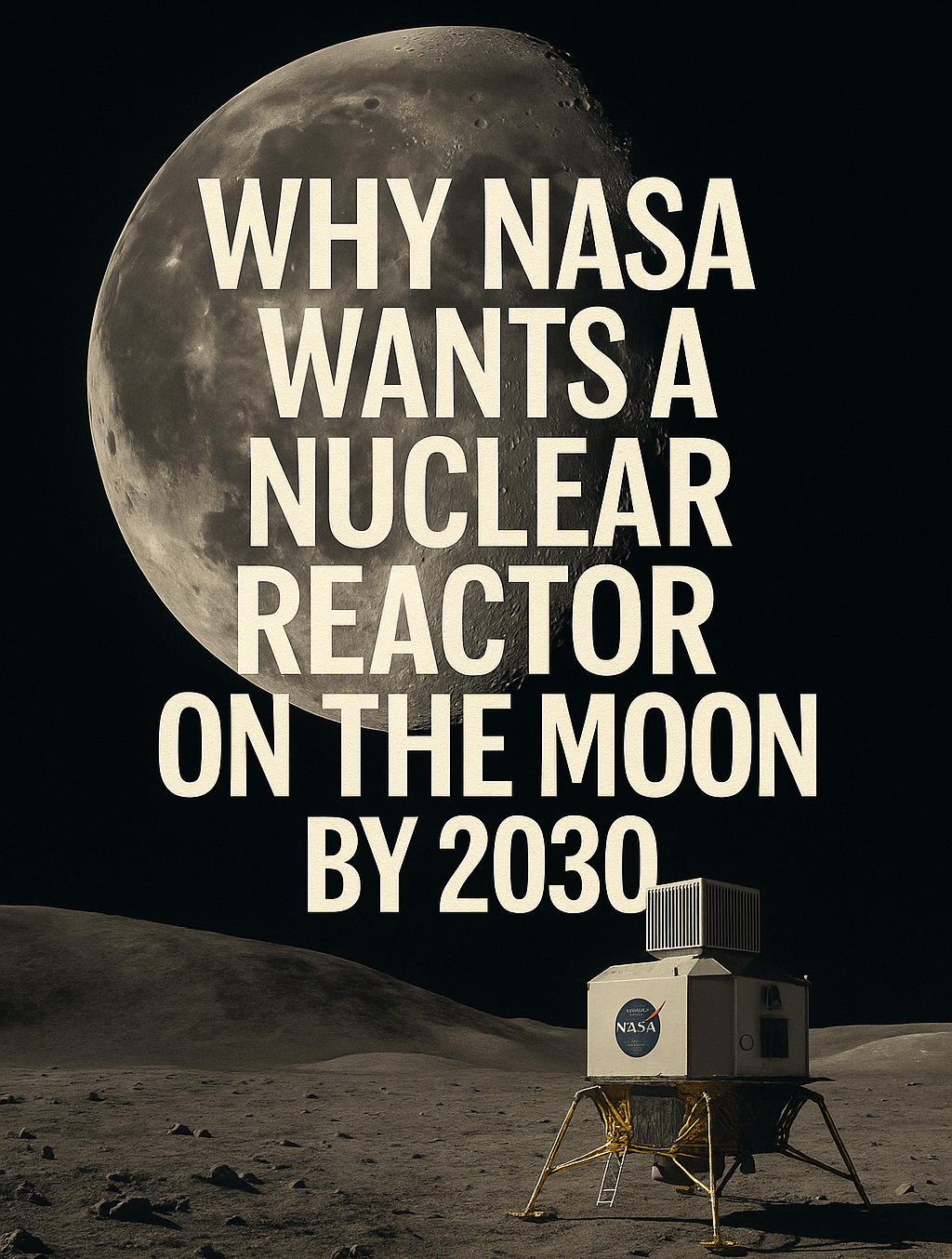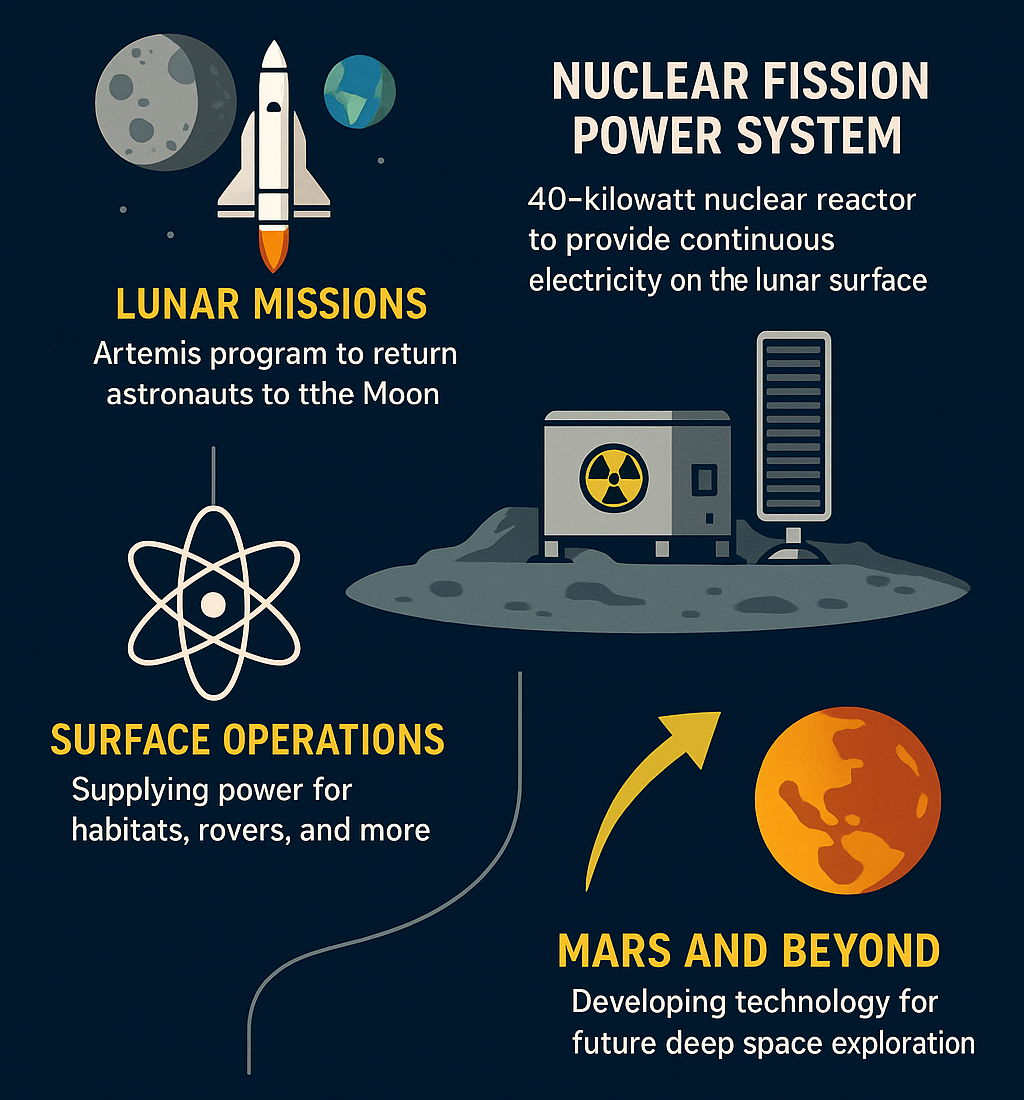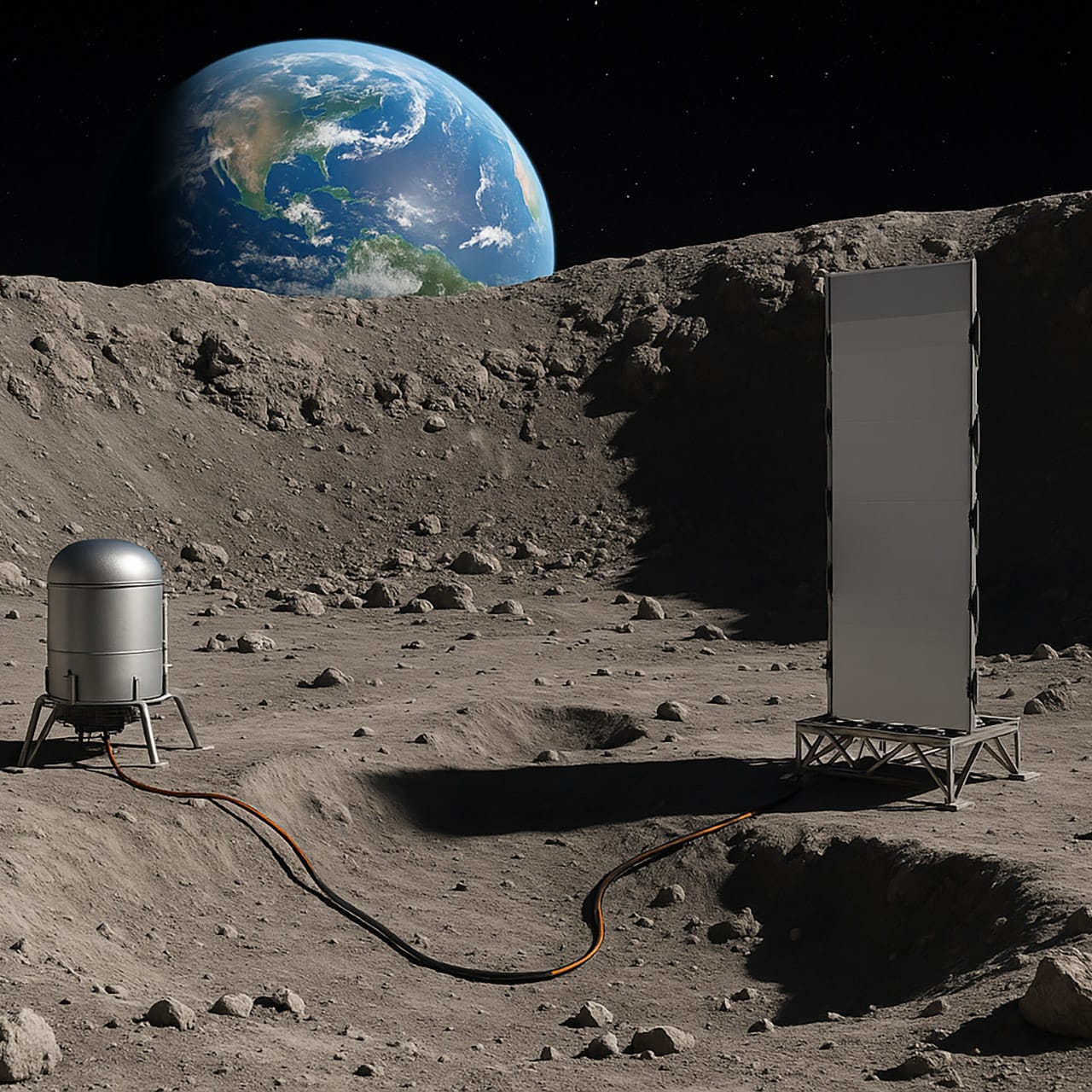From Rockets to Reactors: NASA’s Bold Plan to Power the Moon with Nuclear Energy
This investigative report uncovers the geopolitical race with China and Russia, the engineering challenges of Kilopower technology, and why fission is a game-changer for sustainable deep space exploration and beyond.

Written by Lavanya, Intern, Allegedly The News
WASHINGTON, D.C., August 6, 2025
The image of Neil Armstrong’s bootprint on the lunar soil is a static monument to a singular achievement. But for the next generation of lunar explorers, that solitary footprint must evolve into a sprawling, self-sustaining base, and that requires a power source that is as reliable as it is robust. For decades, solar power has been the workhorse of space exploration, a reliable and clean source of energy in low-Earth orbit and on sunlit Martian plains. However, for a permanent base at the Moon's South Pole, where America's Artemis program aims to land, solar power is fundamentally insufficient. The brutal two-week-long lunar night plunges temperatures to a bone-chilling $-230^{\circ}$C, rendering solar panels useless and forcing systems into a deep freeze.
This is why a new kind of power is now at the heart of a renewed geopolitical race for the Moon: nuclear energy. For NASA, a small nuclear fission reactor is no longer a futuristic concept but a strategic imperative. It promises a continuous, high-output power source that can withstand the lunar night, operate in the permanently shadowed craters believed to hold water ice, and provide the massive energy required to transform the Moon from a destination into a destination where humanity can live and work. This shift from "visit" to "inhabit" hinges on a bold plan to deploy a fission-powered future.
Sean Duffy's Vision and the 2030 Deadline
The push to accelerate this nuclear plan comes directly from interim NASA Administrator Sean Duffy. In a directive dated July 31 and obtained by multiple news outlets, Duffy, who also serves as Transportation Secretary, issued a series of aggressive mandates aimed at fast-tracking the project. This dual-hatted role, an unusual move that has drawn both praise and criticism, signals a new administration's focus on space as a critical piece of national infrastructure rather than purely a scientific pursuit.
Duffy's orders are clear and urgent. He has directed NASA to significantly increase the power target for the reactor from a previously planned 40 kilowatts to a more robust 100 kilowatts. This is a crucial distinction; a 40-kilowatt system could power a small habitat, but a 100-kilowatt system is enough to power an entire lunar outpost, including multiple habitats, rovers, and, most importantly, heavy industrial equipment. This increase in scale is a direct response to the need for a truly sustainable lunar presence.
His directive also set a hard deadline for the project: a 2030 deployment. This timeline is years ahead of previous projections and is driven by a single, powerful motivation: geopolitical competition. Duffy’s directive explicitly warns that if a rival nation, such as China or Russia, were to deploy a nuclear reactor first, it "could declare a keep-out zone which would significantly inhibit the United States." This statement, widely reported by outlets like Politico, has reframed the lunar mission from a matter of scientific achievement to one of strategic national security.
The budgetary context is equally telling. While Duffy's administration faces a proposed budget that could slash funding for some NASA science programs by nearly 50%, the directive shows a clear prioritization of technologies that support crewed missions. This move signals a hard pivot toward "hard-power" capabilities that will enable a permanent human presence on the Moon and Mars.

Timeline of a Fission Future: From Kilopower to a Lunar Base
The roots of NASA’s lunar reactor plan extend back to the Kilopower project, a foundational research effort that proved the concept was viable. From 2015 to 2018, a collaboration between NASA and the Department of Energy developed a small, low-power fission system. The project culminated in the KRUSTY (Kilopower Reactor Using Stirling Technology) test in March 2018, which successfully generated a continuous 5.5 kilowatts of fission power. The test demonstrated that a solid uranium core could safely and reliably generate heat, which was then converted to electricity by Stirling engines.
The current Fission Surface Power program builds directly on this success. The goal now is not a small-scale demonstrator but a flight-ready, 100-kilowatt system designed to operate autonomously for at least ten years. The project has moved into a new phase of development, with private sector partners playing a critical role. Companies like Rolls-Royce, General Electric, and Brayton Energy have been awarded contracts to refine their initial design concepts, focusing on power conversion, heat rejection, and power management systems. The timeline for this development is aggressive: Duffy’s directive calls for an RFP to be issued to industry within 60 days, with a final contractor selection to be made in the coming months. The 2030 launch goal, once seen as a distant possibility, now serves as a hard deadline for a program with decades of foundational research behind it.
The Geopolitical Stakes: A Race Against the Dragon
The urgency of NASA’s new plan is directly tied to the growing ambitions of its chief rival in space: China. In a strategic collaboration with Russia, China has been pursuing the International Lunar Research Station(ILRS), with a stated goal of deploying its own automated lunar nuclear power plant by the mid-2030s. The Chinese government’s space program is known for its methodical, long-term planning and ability to meet deadlines, a stark contrast to the often-politicized and budget-dependent nature of NASA's programs.
This new space race is not a simple repeat of the 20th century. It’s not just about planting a flag; it’s about controlling the energy and resources that will define the future of human activity on the Moon. The lunar South Pole, with its abundant permanently shadowed regions, is believed to hold vast reserves of water ice. The nation that can first establish a continuous power source to mine and process this water will gain a massive strategic advantage. As one senior NASA official told Politico, “It is about winning the second space race.” Without a robust American power source, a rival could effectively "declare a keep-out zone," a concept that could undermine the very foundation of peaceful, open space exploration.
Engineering the Impossible: Safety, Radiation, and the Lunar Environment
Putting a nuclear reactor on the Moon is one of the most complex engineering challenges of the 21st century. The technical "stack" of the reactor includes a solid, low-enriched uranium-235 core, which generates immense heat. This heat is then transferred to Stirling engines via passive sodium heat pipes, a key innovation that eliminates the need for pumps and other moving parts that could fail in the harsh lunar environment. The Stirling engines convert this heat into electrical power.
Safety is paramount, and the design incorporates several key protections. The reactor is launched cold and inert, meaning it will not be activated until it has successfully landed and been deployed on the lunar surface. This design choice eliminates the risk of a nuclear incident during the launch phase or a potential reentry into Earth's atmosphere. Furthermore, the reactor's compact design and solid core make a meltdown scenario virtually impossible.
Once on the Moon, the reactor will be buried under several meters of lunar regolith(soil). This serves a dual purpose: the regolith acts as a natural heat sink, helping to cool the system, and also serves as a radiation shield, protecting astronauts and sensitive equipment from the reactor’s radiation. This simple but ingenious solution drastically reduces the mass of the specialized shielding that would need to be launched from Earth, a significant advantage in a cost-conscious space program.

More Than Power: How a Reactor Changes Everything
A lunar reactor is not just a power source; it is the fundamental infrastructure that will enable a permanent human presence. Its continuous, high-wattage output will power:
- Habitats and Life Support: Providing continuous heating, cooling, and life support systems, eliminating the need for habitats to power down during the lunar night.
- In-Situ Resource Utilization (ISRU): Enabling energy-intensive processes like electrolysis to extract oxygen from lunar regolith and water ice, which can then be used for drinking water, breathable air, and, crucially, rocket fuel for missions to Mars.
- Communications and Mobility: Supporting high-bandwidth communication relays and electric-powered rovers that can operate 24/7, allowing for unprecedented scientific research and exploration.
The Terrestrial Breakthroughs: Clean Energy's Unlikely Origin
The technology being developed for the Moon could have profound impacts on Earth. The need for a compact, reliable, and autonomously operating fission system has driven innovation in a field known as Small Modular Reactors. These SMRs are a new generation of clean energy technology, and the lessons learned from the lunar program could accelerate their development for terrestrial use. This could lead to a new class of clean, distributed power generation for remote communities, military bases, or industrial applications on Earth, providing a powerful return on investment for the lunar program.
The Road Ahead: From Directives to Deployment
The clock is ticking. As of August 5, 2025, the 30-day window for appointing a program executive has closed, and the 60-day window for industry RFPs is open. The next few months will be a critical period as private companies present their designs and compete for the contract. These proposals will not just be technical documents; they will be the blueprints for a new human future in space. This is the time for the public, policymakers, and industry to be engaged, to scrutinize the plans, and to ensure that this bold vision is realized with a focus on both national ambition and international cooperation.
An Energy-Driven Exodus
The theory is that a lunar nuclear reactor is the ultimate enabling technology for humanity to become a multi-planetary species. It fundamentally severs the dependency on Earth for critical resources and power. This single piece of infrastructure transforms lunar missions from temporary expeditions to sustainable settlements, ushering in an era where humanity can truly extend its reach beyond its home planet.
The Lunar Debate: What's Next for Policy and Ethics?
How should international space law, such as the Outer Space Treaty, be updated to address the geopolitical implications of a nation controlling a permanent energy source on the Moon? Given the accelerated timeline, what safeguards are necessary to ensure that technical rigor and safety are not compromised in the rush to beat China and Russia?
Sources
- NASA.gov (Fission Surface Power program page, Kilopower project reports)
- Department of Energy (DOE) and National Nuclear Security Administration (NNSA) publications
- Politico and The New York Times report on Sean Duffy's directives
- Academic papers and technical reports from organizations like the American Nuclear Society
- Reports and analysis from think tanks on the geopolitical implications of space infrastructure
- Quotes and statements from NASA officials, including Trudy Kortes, Fission Surface Power project manager Lindsay Kaldon, and others.




